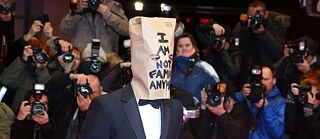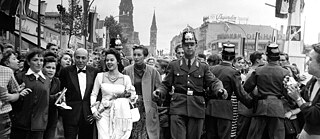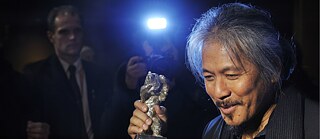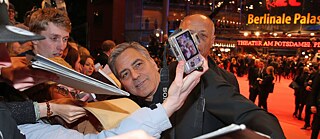Berlinale Bloggers 2020
Looking back on 70 years of festivals

Post-war glamour and glory, scandalous films and a movie star on the red carpet wearing a paper bag over his head: some highlights from the tumultuous history of the world’s biggest film festiva
By Ula Brunner
Titania-Palast in Steglitz, West Berlin, 6 June 1951 — The highly ceremonial opening of the first edition of the Berlin International Film Festival started with a performance by the Berlin Philharmonic Orchestra and a welcoming address by Berlin mayor Ernst Reuter, followed by the screening of Alfred Hitchcock's romantic thriller Rebecca. This box office smash dated from 1940, but that evening in Berlin was its German premiere. The city was jubilant as thousands lined the streets to welcome leading lady Joan Fontaine with a flower parade.
At long last, glamour and glory had returned to the still war-ravaged capital. From the outset, the “Berlinale” in the sectorized city was to put political markers down as a “showcase of the free world”. There were, to be sure, complaints from the east section of Berlin when films from socialist countries were excluded from the official programme (until 1974). But the festival was a hit, and the very next year, the screenings were moved to the centrally located district of Charlottenburg.
Festival directors: the longest and shortest stints running the Berlinale

But Alfred Bauer lasted longest. For a quarter of a century, from 1951 to 1976, the jurist and film historian steered the barque of the fledgling Berlinale through the Cold War and other rough waters. It has just been revealed in an investigative report by the German weekly Die Zeit, however, that Bauer may well have been a high-ranking official in the National Socialist film bureaucracy during the Nazi era. So the Berlinale’s Alfred Bauer Prize will not be awarded in 2020. When Bauer retired, he handed an established A-list film festival over to his successor, Wolf Donner. In three short – but busy – years, Donner then stirred things up by adding a children's film festival (now called Generation) and, far more importantly, by rescheduling the Berlinale… to the winter!
Pompom hats: why winter?
For present-day Berlinale-goers, donning a warm coat and scarf is a must for the February film fest. But it wasn’t always this way. In fact, until 1978, the festival could be enjoyed under balmy summer temperatures, at first even under the stars at the Waldbühne. So why did Wolf Donner move the Berlinale to chilly February?His main argument was that not much was going on at the Filmmesse, the market for the motion picture industry, in the dead of winter. If the International Film Festival were to be held then, Donner reasoned, film producers, buyers and distributors would be drawn to Berlin. And he was right: the Filmmesse flourished in the winter, and its successor, the European Film Market (EFM), now ranks among the most important annual events in the industry.
Longest entry and shortest Berlinale

And the shortest Berlinale to date took place in 1970. German director Michael Verhoeven's anti-war film o.k., about the rape and murder of a Vietnamese girl by US soldiers, sparked heated controversy. The jury, chaired by American director George Stevens, resigned. So Alfred Bauer cancelled the competition, and the Berlinale Bears remained in hibernation for the first and only time in the festival’s history.
Scandals: controversial films

Explicit sex scenes have also made waves. To this day, Japanese director Nagisa Oshima's In the Realm of the Senses (Ai no Corrida), a study in sexual obsession, is still considered the most scandalous film ever shown at the Berlinale. After its first screening in Berlin in 1976, the public prosecutor's office confiscated the film on suspicion of pornography (though the charges were soon dropped).
Even decades later, scenes of frank physicality and intimacy could still cause a stir. The explicit sex scenes in Patrice Chéreau's Intimacy were hotly debated in 2001. Romanian filmmaker Adina Pintilie's debut Touch Me Not, an experimental semi-documentary exploration of intimacy, unsettled plenty of viewers and critics in 2018. But the jury awarded both pictures a Golden Bear.
RED CARPET: Highlights

Speaking of the red carpet: the approximately 1,500-sq-m fabric gets changed once or twice during each festival. So in 2019, the Berlinale opted for sustainability: Berlin's most glamorous floor covering is now made of recycled fishing nets.
The public, the jury and the filmmakers
The Berlinale is now considered the world’s largest film festival in terms of attendance. In 2019, 400 films from 135 different countries were screened to the general public: attendance figures totalled 487,504, including 331,637 paid admissions – nearly double the figure for 2002.One little-known fact about the Berlinale is that from 1952 to 1955, the audience had a say in awarding the Golden and Silver Bears. The festival was accorded A-list status as early as 1956, after which it was entitled to bring in an international jury of experts.
Over the past 70 years, the jury have awarded the Golden Bear to women filmmakers only six times – most recently to Adina Pintilie for her aforementioned Touch Me Not in 2018 – mainly because most of the entries are by male directors. So there’s plenty of room for improvement here in future.